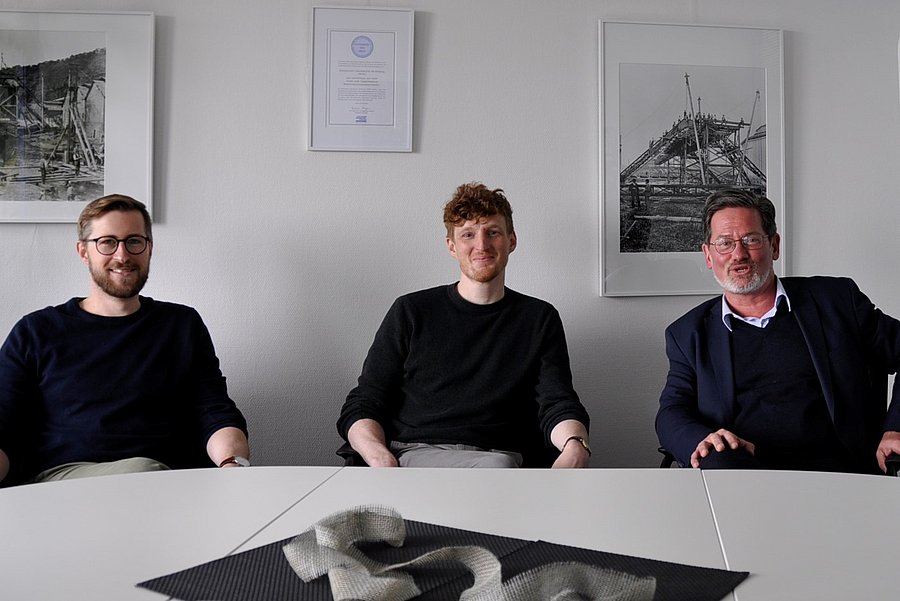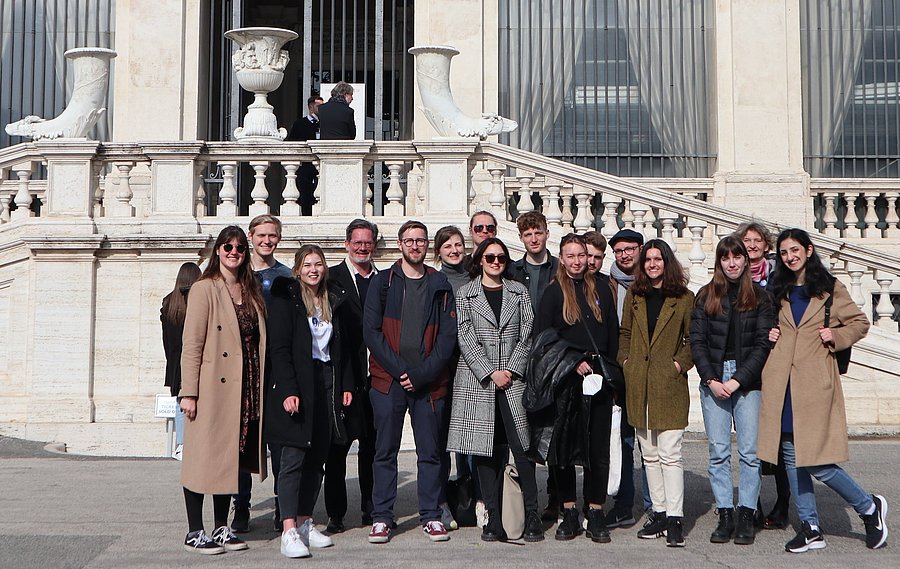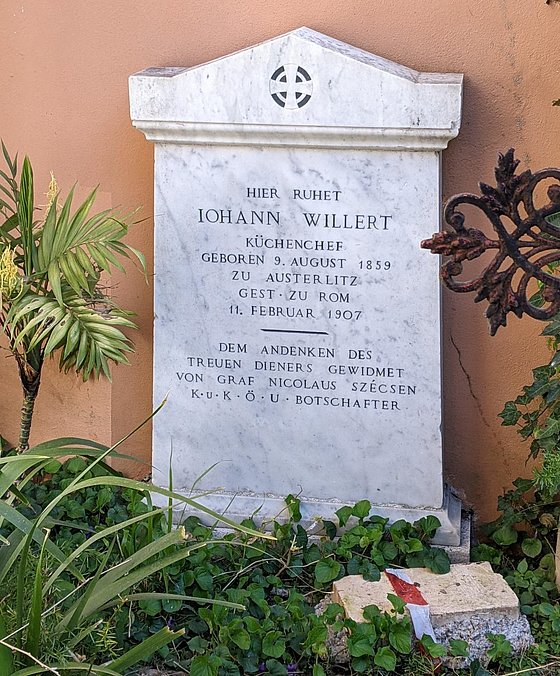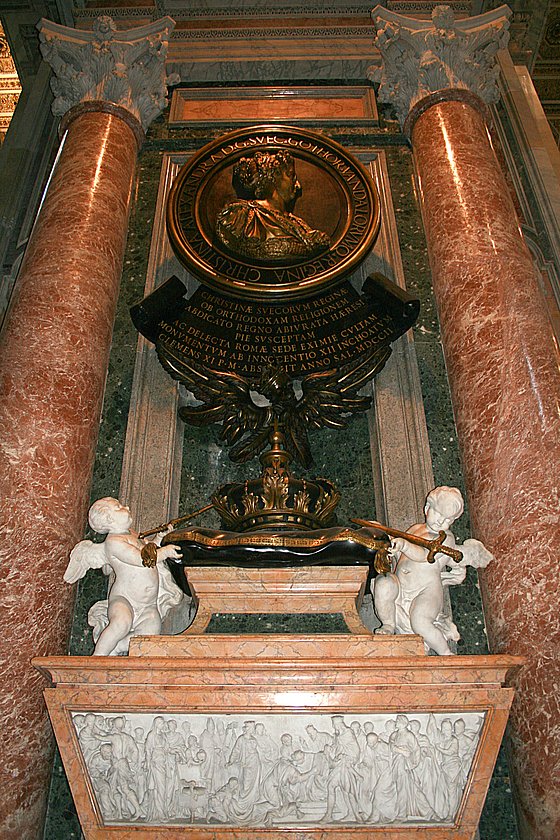
German traces in Rome
Photo from left to right: Michael Schwedt, Jonathan Huppertz, PD Dr. Arne Karsten History
Photo: UniService Transfer
The small piece of the present of the past
An excursion of the history department led by Dr. Arne Karsten in search of German traces in Rome
In the online portal StudyCHECK you can read: 'In order to be able to study history successfully, you should have a comprehensive interest in historical events, old and new languages as well as analytical thinking. ` It becomes especially interesting when opportunities arise to conduct scientific studies directly on site. For this reason, Dr. Arne Kasten, lecturer in modern history at Bergische Universität, regularly organizes excursions that give his students the opportunity to conduct research on the object. Despite the Corona permanent situation, he set out on a research trip to Rome with 15 participants to track down the traces of German scholars and pilgrims in the eternal city. Together with doctoral student Michael Schwedt and master's student Jonathan Huppertz, he reports on the detective work of Wuppertal's young researchers.
Making the sources talk
"The idea was not to simply reel off knowledge and papers, but to get the sources talking in a joint conversation in front of the artworks," says Karsten, "The questions of the students participating for the first time then also repeatedly provided new approaches." In collaboration with his colleague Prof. Dr. Andreas Meier from German Studies, Karsten planned this excursion with concrete tasks, which were then in turn to be implemented on the students' own initiative. "We had structured the whole thing around four main topics," Michael Schwedt reports. "One topic was 'Cardinal Matthäus Schiner (1465 - 1522) and the Swiss Guard`, another dealt with the convert and librarian Lucas Holsten (1596 - 1669) in the service of the Barberini papal family in Rome. The third main topic was the Jesuit Athanasius Kircher (1602 - 1680) and the Jesuit Order. With the fourth topic we then came to the 19th century with the historian Ferdinand Gregorovius (1821 - 1891) and the Italian Risorgimento (Italian unification). So there was always a focal person associated with an institution or a larger principle." Thus, the participants covered a large period of time to focus on groups of people and institutions. The common thread, Schwedt adds, was the theme of `Scholars in Rome`, for which the participants met regularly in the run-up to the excursion and independently planned the approach. "The objects that could be used to show the task of these German traces in Roman urban space were found and selected by the excursion participants themselves," says Schwedt. And since they were already on site, one student even emailed the Swiss Guard to ask about other exciting objects that could have been included. "They actually wrote back, too," Schwedt laughs.

Excursion participants in front of Villa Borghese
Photo: History subject
A German cemetery in the middle of the Vatican
From the Middle Ages onwards, many craftsmen from all over the world settled in Rome. A real colony of foreign citizens developed. Thus also an extensive German life developed, with bakeries - German bread is there still today - churches and also cemeteries, which one must look for however. The Campo Santo Teutonico is an example of a German cemetery in the middle of the Vatican. "It goes back to a brotherhood that was founded there in the 16th century," Jonathan Huppertz explains. "They made it their business to take care of German pilgrims. Of course, this then includes being a point of contact but also later, in the event of death, taking care of a local funeral." Over the years, this quasi-private initiative of compatriots developed into this German cemetery in the center of the Vatican. "It was a brotherhood that initially consisted of a few members who held curial offices," adds Huppertz, "who moved around the papal court, joined together in private initiative and became active on behalf of German pilgrims."
The Campo Santo Teutonico - a cosmos of memories
The Campo Santo Teutonico is one of the last relics of the Holy Roman Empire of the German Nation. The Campo also includes the Church of Santa Maria della Pietà, where many captains of the Swiss Guards are buried. Visitors must report to the Swiss Guardsmen at the gate south of St. Peter's Basilica between the colonnades and the Palazzo del Sant`Uffizio and request access to the German Cemetery or Campo Santo Teutonico in German. For Karsten, there is something rather relieving about this seemingly bizarre procedure. "Above all, it is unusually generous, because the remarkable thing is not that you have to ask for admission, but that you can ask for it without prior notice, without having to apply, without having to send an e-mail, simply in passing and be granted it," the scholar explains. "As a German, you have the right to go there without formality and see the cemetery and the church that adjoins it." And this cemetery really is a fascinating smorgasbord of graves, too, where you always discover something new, Karsten knows. From the common man to artists, scholars and scientists, many dead people are united there, he says. "We discovered a tombstone about a German baker who died in the Sacco di Roma (Sack of Rome) in 1527, depicted with a pretzel. This year I found the grave of the chef of a k.u.k. envoy who died in Rome in 1908, when the count was just ambassador in Rome. He donated a tombstone to his chef in memory. We also found painters and artists who lived and worked in Rome in the 19th century. It's a real cosmos of memories," Karsten enthuses, and Huppertz adds, "It's also a wonderful addition for German travelers if you're just coming from St. Peter's Basilica, which is very crowded. It is visited by huge crowds of tourists, especially if you don't arrive very early. Then the contrast program is with a visit to the cemetery to the side of it, very quiet and contemplative. It is a very beautiful place," and the visitor expects a small piece of the present past, adds Karsten.

Tombstone of the Chef de cuisine
Photo: History subject
More traces in Rome
Catharina Elisabeth Goethe wrote to her son Johann Wolfgang in Rome: 'Dear son ... I would have rejoiced with joy that the wish that had lain in your soul from your earliest youth has now come true...` His travel impressions later appeared under 'Italian Journey' and sparked a widespread longing for Italy. Since the time of humanism many German scholars and artists came to Rome. Their traces can still be discovered today. "This certainly includes the house where Goethe lived at the time," Schwedt begins, "You can find quite a few points of contact for scholars and artists who came to Italy inspired. In Santa Maria dell'Anima, the German national church, you can grasp them very clearly. People like Lucas Holsten show up everywhere because they are in the haze of a powerful papal family," he explains. "Holsten also shows up in St. Peter's Basilica, with Christina of Sweden (Swedish queen from 1632 - 1654). That's where we looked at the tomb, so a monarch and convert who gives up her crown, converts, moves to Rome and spends the rest of her life there. She is accompanied in her conversion by Lucas Holsten, who appears there as a Hamburg scholar. And he is also depicted on the tomb, one that hardly anyone would recognize if they didn't know," and Karsten adds, "It's a large tomb and there is a relief on the sarcophagus where the queen's remains lie. This relief shows the scene of her conversion, where then Lukas Holsten, as a native of Hamburg, is a Protestant himself, and acts as a supervisor of conversion cases in the time of Urban VIII." Scholars like Holsten did not have the means to be the focus of attention themselves at the time, but are always peripherally involved through their service to prominent employers, such as the papal family. Such was the case with the German Jesuit Athanasius Kircher. "He is involved in quite a lot of projects as a Jesuit in Rome," Schwedt knows, "and you only realize that today when you look into it. We had looked at the Four Rivers Fountain in the Piazza Navona, an object that is consistently besieged by tourists. There is an obelisk on top of it and the hieroglyphs remind us of Kircher, because he dealt with it intensively. One recognizes him at the edge, although he is prominent before all eyes. It's like that with a lot of people, they're always somehow involved everywhere and they're also part of this center of power."

Tomb Christina of Sweden in St. Peter's Basilica with relief with Lucas Holsten. He is the blessing clergyman over the queen kneeling before him
Photo: History subject
Santa Maria dell`Anima - final resting place of a German pope.
Santa Maria dell'Anima is the national church of German Catholics, which developed from a hospice foundation. The number of German immigrants must have been so great at some point that a new church was even built from 1499 to 1509. The donations for this also came from Jakob Fugger, the rich. But the German connection goes even further, because the last German pope before Benedict XVI, Pope Hadrian VI, was also buried in this church in 1523. "He originally lay in the old St. Peter's, that is, Old St. Peter's, for about 10 years," Huppertz reports. "At the beginning of the 16th century, they start the new construction of St. Peter's Basilica, and they do it with quite ruthless reconstruction work, so that some important papal tombs are also lost. Hadrian VI also became a victim of these reconstruction measures. But fortunately the tomb was then transferred to the German National Church. It's significant that it went there because it financed one of his closest friends, Cardinal Willem van Enckenvoirt, the only cardinal Hadrian appointed during his short tenure."
Of course, Rome is also the city of the dead, Karsten explains, and that is very important to the pre-modern world of thought and can be studied beautifully in Rome. The remembrance of the deceased, the conscious staging of the important dead, belongs to the living world of the posterity and is thus also the setting of a sign of remembrance.
Kingdom of Italy allows the construction of a Lutheran Church
There is also a Lutheran Church in Catholic Rome. Its architect, Franz Schwechten, built the Kaiser Wilhelm Memorial Church in Berlin. In 1910, the building project was finally realized. "This is very closely related to the Kingdom of Italy, when Rome ceased to be the capital of popes and became the capital of kings," says Schwedt, "the precursor of this church foundation we had looked at earlier when we were on the Capitol. There's the Palazzo Caffarelli and that's where the Prussian legation used to be." For in fact, Lutheran services had already been celebrated there in a house chapel from 1817, and from 1819 even with their own pastor. "There was already this Lutheran congregational life taking place in the heart of Rome. The pope didn't like that, but they didn't want a dispute with the Prussian legation, so they tolerated it," Schwedt explains.
Not tolerated, on the other hand, were deceased non-Catholics, who were not allowed to be buried within the city. "There's the Cimitero Acattolico," Karsten says, "where heretics are allowed to bury their dead. That's where Goethe's son lies, for example, and many other Protestant artists and scholars." Visibly having a building within the Papal States dedicated to another cult was completely unthinkable, he says. However, after troops of the Italian king conquered Rome in 1870, the way was clear for the construction of a Protestant church. "The entire city area was now the responsibility of the Kingdom of Italy, and that led to other denominations being able to acquire building land," Schwedt says.
Since 2015, there has been a Martin Luther Square near the Colosseum
Even in the 21st century, German influences can still be traced in Rome, such as Martin Luther Square (Piazza Martin Lutero), which was renamed six years ago. Scholars, on the other hand, continue to discover new things about old objects. "I was very pleased," Karsten sums up, "that the concept of the excursion worked. The idea was not to lecture masses of knowledge, but to take the historical source seriously together and try to make history come alive from dealing with the individual objects on the basis of student initiative," and Schwedt adds: "For me it was very interesting this time to learn more about these scholar figures in the second row, how important they are in the overall context of developments. German traces in Rome can always be discovered in the urban space through Holsten, Kircher or others. Baroque Rome, as an ensemble of buildings created in a fairly short period of time, still characterizes the city today. And there many Germans have contributed in the second row."
Uwe Blass (interview from 06.04.2022)
PD Dr. Arne Karsten (*1969) studied art history, history and philosophy in Göttingen, Rome and Berlin. From 2001 to 2009 he was a research assistant at the Institute for Art and Image History at Humboldt University Berlin. Since the winter semester of 2009, he has been teaching as a junior professor, and since his habilitation in 2016, as a private lecturer in modern history at Bergische Universität.
Michael Schwedt (*1988) studied History and German Studies at Bergische Universität Wuppertal until he received his Master of Education and Master of Arts degrees. He is currently working on his history dissertation on the fall of the Republic of Venice under the supervision of PD Dr. Arne Karsten and has been a project assistant in German Studies at BU since November 2021.
Jonathan Huppertz (*1995) is currently studying History and English at the University of Wuppertal in the Master of Education.
